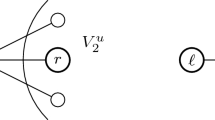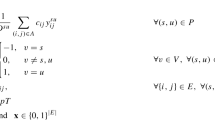Abstract
Let \(D=(V,A)\) be a digraph with a set of vertices V, and a set of arcs A, with \(c_{ij} \in {\mathbb {R}}\) representing the cost of each arc \((i,j) \in A\). The problem of finding the shortest-path avoiding negative cycles (SPNC) is NP-hard and consists in determining, if it exists, a path of minimum cost between two distinguished vertices \(s \in V\), and \(t \in V\). We propose three exact solution approaches for SPNC, including a compact primal-dual model, a combinatorial branch-and-bound algorithm, and a cutting-plane method. Extensive computational experiments performed on both benchmark and randomly generated instances indicate that our approaches either outperform or are competitive with existing mixed-integer programming models for the SPNC while providing optimal solutions for challenging instances in small execution times.
Similar content being viewed by others
References
Andrade, R. C., Araújo, K. A. G., & Saraiva, R. D. (2015). Um método primal-dual para o problema do caminho mínimo em digrafos na presença de ciclos absorventes. XLVII Simpósio Brasileiro de Pesquisa Operacional (pp. 2904–2911) (in Portuguese).
Andrade, R. C., & Freitas, A. T. (2013). Disjunctive combinatorial branch in a subgradient tree algorithm for the DCMST problem with VNS-lagrangian bounds. Electronic Notes in Discrete Mathematics, 41, 5–12.
Batsyn, M., Goldengorin, B., Kocheturov, A., & Pardalos, P. M. (2013). Tolerance-based vs. cost-based branching for the asymmetric capacitated vehicle routing problem. In B. Goldengorin, V. Kalyagin & P. Pardalos (Eds.), Models, algorithms, and technologies for network analysis. Springer proceedings in mathematics & statistics (Vol. 59, pp. 1–10). New York, NY: Springer.
Desrochers, M., & Laporte, G. (1991). Improvements and extensions to the Miller–Tucker–Zemlin subtour elimination constraints. Operations Research Letters, 10(1), 27–36.
Drexl, M. (2013). A note on the separation of subtour elimination constraints in elementary shortest path problems. European Journal of Operational Research, 229(3), 595–598.
Gu, X., Madduri, K., Subramani, K., & Lai, H. (2009). Improved algorithms for detecting negative cost cycles in undirected graphs. In X. Deng, J. E. Hopcroft & J. Xue (Eds.), Frontiers in algorithmics. FAW 2009. Lecture Notes in Computer Science (Vol. 5598, pp. 40–50). Berlin: Springer.
Haouari, M., Maculan, N., & Mrad, M. (2013). Enhanced compact models for the connected subgraph problem and for the shortest path problem in digraphs with negative cycles. Computers & Operations Research, 40(10), 2485–2492.
Hougardy, S. (2010). The floyd-warshall algorithm on graphs with negative cycles. Information Processing Letters, 110(8), 279–281.
Ibrahim, M. S. (2007). Etude de formulations et inégalités valides pour le problème du plus court chemin dans les graphes avec des circuits absorbants. PhD thesis, Université Pierre et Marie Curie, Paris, France.
Ibrahim, M. S. (2015). A strong class of lifted valid inequalities for the shortest path problem in digraphs with negative cost cycles. Journal of Mathematics Research, 7(4), 162–166.
Ibrahim, M. S., Maculan, N., & Minoux, M. (2009). A strong flow-based formulation for the shortest path problem in digraphs with negative cycles. International Transactions in Operational Research, 16(3), 361–369.
Ibrahim, M. S., Maculan, N., & Minoux, M. (2015a). Le Problème Du Plus Court Chemin Avec Des Longueurs Negatives. Saarbrucken (Allemagne): Editions universitaires européennes.
Ibrahim, M. S., Maculan, N., & Minoux, M. (2015b). Valid inequalities and lifting procedures for the shortest path problem in digraphs with negative cycles. Optimization Letters, 9(2), 345–357.
Ibrahim, M. S., Maculan, N., & Ouzia, H. (2016). An efficient cutting plane algorithm for the minimum weighted elementary directed cycle problem in planar digraphs. RAIRO-Operations Research, 50(3), 665–675.
Mehlhorn, K., Priebe, V., Schäfer, G., & Sivadasan, N. (2002). All-pairs shortest-paths computation in the presence of negative cycles. Information Processing Letters, 81(6), 341–343.
Miller, C. E., Tucker, A. W., & Zemlin, R. A. (1960). Integer programming formulation of traveling salesman problems. Journal of the ACM (JACM), 7(4), 326–329.
Pugliese, L. P., & Guerriero, F. (2016). On the shortest path problem with negative cost cycles. Computational Optimization and Applications, 63(2), 559–583.
Sherali, H. D., & Adams, W. P. (1990). A hierarchy of relaxations between the continuous and convex hull representations for zero-one programming problems. SIAM Journal on Discrete Mathematics, 3(3), 411–430.
Subramani, K. (2007). A zero-space algorithm for negative cost cycle detection in networks. Journal of Discrete Algorithms, 5(3), 408–421.
Subramani, K., & Kovalchick, L. (2005). A greedy strategy for detecting negative cost cycles in networks. Future Generation Computer Systems, 21(4), 607–623.
Taccari, L. (2016). Integer programming formulations for the elementary shortest path problem. European Journal of Operational Research, 252(1), 122–130.
Yamada, T., & Kinoshita, H. (2002). Finding all the negative cycles in a directed graph. Discrete Applied Mathematics, 118(3), 279–291.
Acknowledgements
The authors are grateful to CNPq for Grant 449254/2014-3 and to the anonymous referees for their valuable comments and suggestions.
Author information
Authors and Affiliations
Corresponding author
Additional information
This work was supported by CNPq (Grant 449254/2014-3).
Rights and permissions
About this article
Cite this article
de Andrade, R.C., Saraiva, R.D. MTZ-primal-dual model, cutting-plane, and combinatorial branch-and-bound for shortest paths avoiding negative cycles. Ann Oper Res 286, 147–172 (2020). https://doi.org/10.1007/s10479-017-2743-5
Published:
Issue Date:
DOI: https://doi.org/10.1007/s10479-017-2743-5










